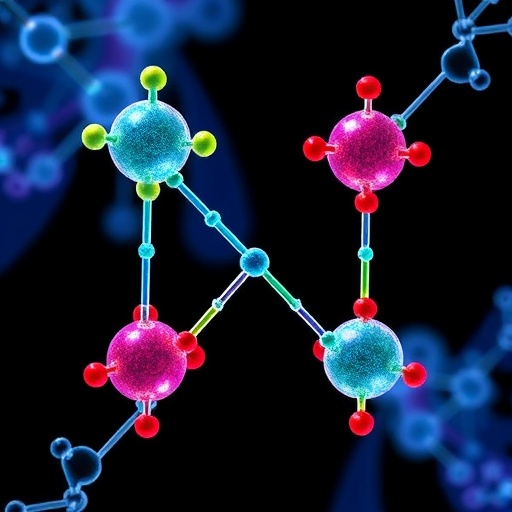A revolutionary breakthrough in polymer science promises to redefine the boundaries between sustainability and stability in advanced materials. Researchers led by Professor Xiaokong Liu at Jilin University have engineered a controllable, reversible switch between dynamic covalent polymers and thermosetting polymers by employing a clever “activation-quenching” strategy rooted in dynamic covalent chemistry. This transformative approach offers a sophisticated solution to a longstanding challenge: balancing the recyclability of dynamic materials with the robust thermal and mechanical performance traditionally exclusive to thermosets.
Thermosetting polymers have long been prized for their exceptional mechanical strength, thermal durability, and resistance to solvents, making them ubiquitous in automotive, aerospace, and electronic applications. However, their permanent covalent cross-linked networks render them irreversibly set, preventing any form of melt processing or recycling. This intractability imparts significant environmental costs, as thermosets typically become persistent waste. Conversely, dynamic covalent polymers, also recognized as covalent adaptable networks (CANs), introduce reversible bonds allowing network rearrangement and recyclability via thermally activated bond exchange reactions. Yet, these materials suffer from compromised thermal stability, exhibiting detrimental creep and loss of dimensional integrity when exposed to elevated temperatures—a critical limitation that hampers their real-world application.
The novelty of this study lies in the ingenious exploitation of phenol-yne click chemistry combined with acid-base chemistry to modulate the dynamic exchange reactions of covalent bonds within the polymer matrix. The team developed a reversible system wherein the nucleophilicity of phenoxy anions can be toggled effectively through protonation and deprotonation events. In the “activated” state, the deprotonated phenols engage in dynamic bond exchanges via an addition-elimination mechanism, imparting the polymer with adaptability and reprocessability. When acid is introduced, it protonates these phenoxy anions, drastically reducing their nucleophilic reactivity and thereby “quenching” the bond exchange dynamics, locking the polymer into a stable thermoset configuration with retention of original shape and mechanical properties. By reversing the process with base treatment, the dynamics “reactivate,” enabling recycling and reshaping.
To realize this chemically switchable network, the researchers synthesized a dynamic covalent polymer by polymerizing triphenol and diyne monomers catalyzed by cesium carbonate (Cs₂CO₃) to maintain an alkaline, activated environment. This enabled the formation of phenol-yne adducts amenable to bond exchange. Subsequent acid treatment transformed the material into a classic thermoset, raising the glass transition temperature (T_g) by approximately 40 °C and decomposition temperature by 70 °C relative to the activated state. This dramatic enhancement allowed the quenched thermoset to withstand high-temperature applications with excellent creep resistance up to 160 °C, a substantial leap beyond the compromised stability (~80 °C) of conventional dynamic CANs.
Crucially, this interplay did not compromise mechanical performance, with the quenched thermosetting polymers preserving the structural and strength characteristics of the initial dynamic materials. Furthermore, the ability to return the quenched polymer back to its dynamic, recyclable state through simple base treatment introduces a versatile on-demand switching protocol. This feature paves the way for sustainable lifecycle management of polymeric materials, combining eco-conscious reusability with end-use performance requirements.
The implications of this work reach far beyond the immediate polymer systems investigated. The “quenching-activation” methodology represents a generalizable platform technology that can be extended to other advanced functional materials, including dynamic covalent liquid crystal networks and shape-memory polymers. These systems often confront similar dilemmas between responsiveness triggered by thermal stimuli and unwanted network relaxation or degradation. The ability to switch between dynamic and static network states precisely on demand offers a powerful handle to tailor material properties and lifecycle behaviors to specific application needs.
From a fundamental chemistry viewpoint, the study illuminates the crucial role of protonation state control in modulating nucleophilic reactivity within a polymer network environment. By harnessing reversible acid-base chemistry, it offers a straightforward, scalable, and low-energy approach to dynamically sculpting polymer architectures post-synthesis—a notable departure from conventional thermal or photochemical switching strategies that often require specialized equipment or induce irreversible damage.
Importantly, the research team’s interdisciplinary effort, combining synthetic polymer chemistry with mechanistic insights and detailed thermal-mechanical characterization, provides a comprehensive blueprint for developing next-generation adaptable materials. Collaborations with experts from the University of Colorado Boulder further enriched the study, underscoring its global scientific significance. Funding support from major Chinese science foundations and national research programs highlights the strategic importance of sustainable polymer science in the context of environmental stewardship and technological innovation.
Published as an open-access article in CCS Chemistry, the flagship journal of the Chinese Chemical Society, the findings ensure broad dissemination and adoption potential across the international materials science community. The work not only marks a milestone in dynamic polymer chemistry but also resonates with pressing sustainability challenges faced by the polymer industry worldwide, advocating for materials designed for circular lifecycles without compromising performance.
Looking ahead, this dynamic switching paradigm may trigger a paradigm shift in how polymers are conceptualized, manufactured, and recycled. The unlocking of chemical “on-off” switches within covalent networks provides material scientists a new degree of freedom to engineer polymers that can operate in high-performance regimes yet readily revert to reprocessable forms after use. This duality embodies the future of smart, sustainable materials—combining environmental responsibility with uncompromising functionality.
In closing, the innovation led by Professor Xiaokong Liu’s group elegantly balances the historically opposing demands of thermoset durability and dynamic polymer sustainability. By introducing a facile chemical switch to toggle between these states, the research opens fertile ground for the creation of advanced material platforms that meet the rising global imperatives for sustainability, recyclability, and high performance. This breakthrough is poised to catalyze further exploration and exploitation of dynamic covalent chemistries in intelligent polymer design.
Subject of Research: Not applicable
Article Title: Controlled Switching Between Covalent Adaptable Networks and Thermosets
News Publication Date: 11-Oct-2025
Web References:
https://www.chinesechemsoc.org/journal/ccschem
http://dx.doi.org/10.31635/ccschem.025.202506334
References:
Minghao Wu, et al., “Controlled Switching Between Covalent Adaptable Networks and Thermosets,” CCS Chemistry, 2025, DOI: 10.31635/ccschem.025.202506334
Image Credits: CCS Chemistry
Keywords
Supramolecular chemistry
Tags: activation-quenching strategycovalent adaptable networksdynamic covalent polymersenvironmental impact of polymer wasteinnovative polymer science researchmechanical performance of thermosetsphenol-yne click chemistry applicationspolymer recyclability solutionsreversible switching in polymerssustainable advanced materialsthermal stability in polymersthermosetting polymers





